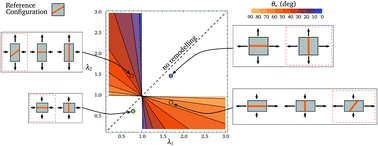Torque-induced reorientation in active fibre-reinforced materials
Abstract
We introduce a continuum model for a fibre reinforced material in which the reference orientation of the fibre may evolve with time, under the influence of external stimuli. The model is formulated in the framework of large strain hyperelasticity and the kinematics of the continuum is described by both a position vector and by a remodelling tensor which, in the present context, is an orthogonal tensor representing the fibre reorientation process. By imposing suitable thermodynamical restrictions on the constitutive equation, we obtain an evolution equation of the remodelling tensor governed by the Eshelby torque, whose stationary solutions are studied in absence of any external source terms. It is shown that the fibres reorient themselves in a configuration that minimises the elastic energy and get aligned along a direction that may or may not be of principal strain. The explicit analysis of the Hessian of the strain energy density allows us to discriminate among the stationary solutions, which ones are stable. Examples are given for passive reorientation processes driven by applied strains or external boundary tractions. Applications of the proposed theory to biological tissues, nematic or magneto-electro active elastomers are foreseen.



 Please wait while we load your content...
Please wait while we load your content...